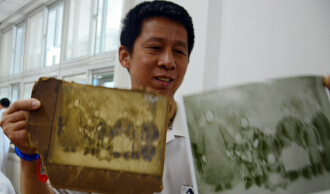New joint command system 'on way'
By ZHAO SHENGNAN ( China Daily ) Updated: 2014-01-03 01:45:09The Chinese military is to establish a joint operational command system "in due course", with observers saying this will result in more-coordinated and combat-capable forces to efficiently respond to a crisis.
Setting up the system is a basic requirement in an era of information, and the military has launched positive pilot programs in this regard, the Ministry of National Defense told China Daily on Thursday.
The remarks came shortly after a Japanese media report said China is considering reorganizing its seven military regions into five.
Each of the new military regions would create a joint operations command controlling the army, navy and air force as well as a strategic missile unit, the report said.
On Wednesday, the Yomiuri Shimbun newspaper said the planned revamp would mark a shift from the defense-oriented military, which relies mainly on the army, to one ensuring more mobile and integrated management.
The ministry said in a reply to China Daily that the modernization of the military is not targeted at any country.
Observers said the military's structural reform, which was underscored by a landmark reform plan adopted by the Third Plenum of the 18th Communist Party of China Central Committee in November, is gathering pace as the country increases sophisticated technology but also faces different security challenges.
The reform plan seeks to "improve the combined combat command systems, push forward reform of training and logistics for joint combat operations".
Ouyang Wei, a professor at the National Defense University of the People's Liberation Army, said a joint operational command system highlights unified command and information sharing across at least two different military forces.
It would help the military respond quickly to a contingency, he said, adding, "The system, which has been popular in the West for decades, is not (aimed at) starting a war, but to kill it in the cradle."
Zhao Xiaozhuo, deputy director of the center on China-US defense relations at the PLA Academy of Military Science, said the seven military regions were established in 1985, with the army as the backbone force.
China has been trying to optimize the allocation of these military regions, given that incidents are increasingly likely to happen at sea, said Zhao, citing as an example the Diaoyu Islands, the group of islets in the East China Sea that Japan illegally "nationalized" in 2012.
"An increasingly efficient military will not necessarily be a more aggressive one. China has made its peaceful stand clear, but it is time to improve its combat ability," he said.
Li Qinggong, deputy secretary-general of the China Council for National Security Policy Studies, said the country will further boost its high-tech naval, air and nuclear forces that started developing much later than its army.
The navy is probably the highest priority, including having more aircraft carriers and stronger fleets, he said.
"China has built an iron bastion in its border regions. The major concern lies at sea," Li said.
The Chinese navy conducted a series of increasingly complex and powerful thrusts into the Pacific Ocean in 2013.
Its sole aircraft carrier returned to its home port in East China on Wednesday after completing tests and training in the South China Sea for the first time.
But both the navy's development and the military's structural reform will take time, said Lin Dong, a professor at National Defense University.
Ouyang said China should train more commanders who are skilled in various areas, and make more breakthroughs in information technology.
|
|
|
|
|
|
|
|


















 Op Rana
Op Rana Berlin Fang
Berlin Fang Zhu Yuan
Zhu Yuan Huang Xiangyang
Huang Xiangyang Chen Weihua
Chen Weihua Liu Shinan
Liu Shinan